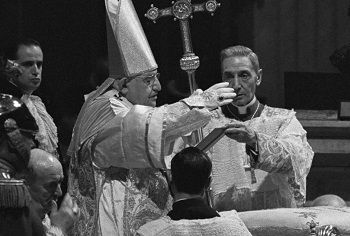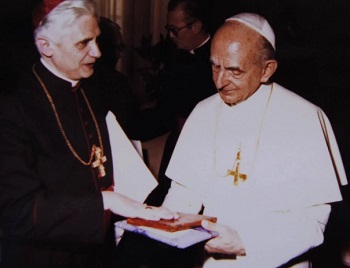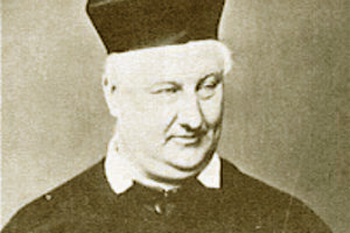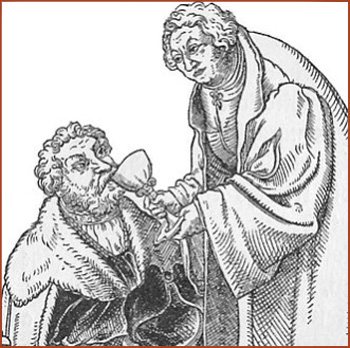Asuntos Tradicionalistas
 |
 |
 |
 |
 |
 |
 |
Misa Dialogada - CXLIII
La Doctrina Luterana de Ratzinger sobre la
Presencia Real
“Nam et loquela tua manifestum te facit”: (Mateo 26:73) (Incluso tu discurso te delata)
La objeción de Ratzinger al lenguaje “cristalino” del Escolasticismo, junto con su desprecio inveterado por la “tradición manualista,” sugiere una intención (compartida por todos los neo-modernistas) de separarse no solo de la forma de la teología católica, sino también de su substancia. Esa intención fue hábilmente camuflada en el Discurso de Apertura del Concilio de Juan XXIII con su conocido lugar común:
“La substancia de la antigua doctrina del depósito de la fe es una cosa, y la forma en que se presenta, con el mismo significado y juicio, es otra.”
Pero si la substancia de la Fe no tiene relación esencial con la forma en que se presenta, es decir, con el lenguaje en el que se expresa, como parece implicar el aforismo de Juan XXIII, no podemos siquiera comenzar a hablar de “mismo significado y juicio” porque no habría criterios lingüísticos objetivos con los que establecer qué es verdadero o no. Simplemente perderíamos la capacidad de transmitir con certeza la verdad ontológica sobre “ser” (“lo que es”) – especialmente el Ser Supremo (“Yo Soy”, Éxodo 3:14) – y su significado.
 Precisamente aquí es donde entra el Escolasticismo – para proporcionar a la Iglesia un estándar universal de expresión con el que puede presentar la Verdad inmutable de manera lógica y coherente, independientemente del tiempo o lugar. Con la desaparición del Escolasticismo, es obvio que nos hemos convertido en meros juguetes de teólogos y reformadores que desean imponer sus propios significados a través del uso de un lenguaje calculado para manipular nuestras mentes.
Precisamente aquí es donde entra el Escolasticismo – para proporcionar a la Iglesia un estándar universal de expresión con el que puede presentar la Verdad inmutable de manera lógica y coherente, independientemente del tiempo o lugar. Con la desaparición del Escolasticismo, es obvio que nos hemos convertido en meros juguetes de teólogos y reformadores que desean imponer sus propios significados a través del uso de un lenguaje calculado para manipular nuestras mentes.
Era una práctica común entre los teólogos progresistas en el Concilio, incluido el P. Ratzinger, rechazar los esquemas originales que habían sido preparados por sus contrapartes conservadoras. Al reformular el lenguaje del esquema sobre la Constitución de la Iglesia, por ejemplo, Ratzinger mostró su determinación de no mantener el mismo significado que el documento original:
“El nuevo texto describe la relación entre la Iglesia y los cristianos no católicos sin hablar de ‘pertenencia.’ Al desprenderse de esta armadura terminológica, el texto adquirió un alcance mucho más amplio.” 1
Como teólogo, Ratzinger compartía mucho en común con sus compañeros neo-modernistas de la era del Vaticano II en su aversión a las “fórmulas fijas” del Escolasticismo en toda una gama de verdades sustanciales del catolicismo relacionadas con el concepto de “ser.” Estas incluían la enseñanza tradicional sobre la Presencia Real, la naturaleza de la Iglesia como una institución monárquica, la Revelación como cerrada de manera definitiva, la indisolubilidad del matrimonio y otros dogmas definidos que son inaceptables, especialmente para los protestantes. El escepticismo de Ratzinger sobre todos estos temas está documentado en varios puntos a lo largo de estos artículos.
Debido a la seriedad del tema, y al deseo de ser escrupulosamente preciso, tomaremos la fuente original de las declaraciones de Ratzinger tal como fueron escritas en las versiones alemanas, antes de que fueran un tanto “blanqueadas” en traducciones posteriores. La énfasis se colocará no en lo que él mismo creía personalmente – esto es difícil de determinar debido a las ambigüedades y circunloquios de su estilo – sino en el contenido de sus declaraciones y cómo las presentó.
La Presencia Real
De todas las áreas de la doctrina católica en las que la ausencia del pensamiento escolástico se siente más agudamente, debe ser la doctrina de la Presencia Real. Cuando Pablo VI publicó su Encíclica Mysterium Fidei en 1965, reconoció que había una crisis de creencia en la Eucaristía, especialmente en la Presencia Real. Culpa en gran parte a aquellos que en palabra hablada y escrita “difunden opiniones que perturban a los fieles y llenan sus mentes de no poca confusión sobre asuntos de fe.” (§ 10)
La situación no podría ser más irónica: uno de los teólogos en cuestión, un joven académico llamado P. Joseph Ratzinger (quien eventualmente se convertiría en uno de los sucesores de Pablo VI) estaba en ese momento ocupado difundiendo confusión sobre la Presencia Real con teorías sutiles y enrevesadas. En 1966, Ratzinger escribió lo siguiente:
 “La adoración eucarística o la visita silenciosa en una iglesia no pueden razonablemente ser solo una conversación con el Dios que se piensa [sic] que está localmente presente en un espacio confinado. Declaraciones como ‘Dios vive aquí’ y la conversación con el Dios que se piensa [sic] que está localmente presente de esta manera expresan un malentendido del misterio cristológico tal como el concepto de Dios, que necesariamente repele a la persona pensante que conoce sobre la omnipresencia de Dios.
“La adoración eucarística o la visita silenciosa en una iglesia no pueden razonablemente ser solo una conversación con el Dios que se piensa [sic] que está localmente presente en un espacio confinado. Declaraciones como ‘Dios vive aquí’ y la conversación con el Dios que se piensa [sic] que está localmente presente de esta manera expresan un malentendido del misterio cristológico tal como el concepto de Dios, que necesariamente repele a la persona pensante que conoce sobre la omnipresencia de Dios.
“Si uno quisiera justificar ir a la iglesia diciendo que hay que visitar al Dios que solo está presente allí, entonces esto sería en efecto una razón que no tiene sentido, y sería justamente rechazada por las personas modernas.” 2
Todo el pasaje plantea una pregunta que nunca debería ocurrirle a un verdadero católico: ¿Está realmente Cristo presente en el sagrario, o solo se piensa que está allí? En otras palabras, ¿es la Presencia Real solo un producto de la imaginación de algunas personas? Estos comentarios, publicados por primera vez en 1966, inevitablemente causaron una cierta cantidad de escándalo entre los fieles, y hubo una reacción de crítica airada hacia su autor. Hoy en día, es más probable que sean recibidos con un encogimiento de hombros de indiferencia.
En respuesta, Ratzinger trató de justificarse en una publicación posterior, Dios está cerca de nosotros, diciendo que había habido “un malentendido” por parte de sus críticos, y que sus comentarios no niegan la Presencia Real ni se oponen a la adoración.3 Sin embargo, en la comprensión normal de sus palabras, ciertamente parecían implicar ambas cosas.
 Además, el pasaje ignora lo que la Iglesia ha enseñado sobre el estatus único de la presencia de Cristo en la Eucaristía. Siempre se ha creído que, aunque Dios está en todas partes (y había estado así antes de la Encarnación), Él está sacramentalmente presente en la Eucaristía en la plenitud de su naturaleza corporal (Cuerpo y Sangre) así como en su naturaleza espiritual (Alma y Divinidad).
Además, el pasaje ignora lo que la Iglesia ha enseñado sobre el estatus único de la presencia de Cristo en la Eucaristía. Siempre se ha creído que, aunque Dios está en todas partes (y había estado así antes de la Encarnación), Él está sacramentalmente presente en la Eucaristía en la plenitud de su naturaleza corporal (Cuerpo y Sangre) así como en su naturaleza espiritual (Alma y Divinidad).
El sacerdote oratoriano del siglo XIX, P. Frederick William Faber, por ejemplo, no tuvo dificultades en aceptar la presencia del “Verbo Eterno, Incomprensible, Todopoderoso que está en todas partes y, sin embargo, está fijado allí,” aunque El elige residir en “la tranquila modestia del Santísimo Sacramento.” 4 No solo el hombre moderno rechaza esta enseñanza – la queja inicial (Juan 6:61) contra ella ha sido reiterada desde los tiempos de Nuestro Señor: “Este es un lenguaje intolerable. ¿Quién podría aceptarlo?”
La transubstanciación no es un tema para ‘diálogo’
El Papa Benedicto XVI luego reformuló la doctrina de la transubstanciación en términos que no solo vaciaron a la Eucaristía de su significado, sino que, en más de una ocasión, se adentraron en el campo protestante, si sus palabras deben ser juzgadas de acuerdo con la solemne definición del Concilio de Trento.
Durante su tiempo en el cargo papal, por ejemplo, escribió una trilogía sobre Jesús de Nazaret (reseñas aquí y aquí), enfatizando el hecho de publicarla bajo su propio nombre; explicó la razón en el Prefacio al Volumen 1: Fue “en ningún sentido un acto magisterial, sino más bien una expresión de mi búsqueda personal ‘del rostro del Señor.’ (Sal 27:8)” 5 (N.B. el numerado del Salmo no corresponde a la tradicional edición de la Biblia Douay-Rheims, sino que adopta la versión protestante por razones “ecuménicas”).
Quiso que se supiera que solo hablaba como un simple creyente, Joseph Ratzinger, un cristiano, a cualquiera que deseara escuchar, añadiendo que “todos son libres de discrepar conmigo.” Así, habiendo renunciado a la Tiara papal, ahora dejaba de lado su mitra papal. En esta capacidad, soltó la siguiente bomba:
“El llamado relato institucional, es decir, las palabras y gestos con los que Jesús se dio a los discípulos en pan y vino, forman el núcleo de la tradición de la Última Cena.” 6 [Énfasis añadido]
 La formulación es indudablemente luterana, siendo una expresión de la consubstanciación, que postula que Cristo está sustancialmente presente con y en el pan y el vino.7 En caso de que haya alguna duda sobre las palabras precisas que usó Ratzinger, uno puede referirse a la versión original en alemán que muestra una correspondencia exacta con la correcta traducción al inglés dada arriba.8
La formulación es indudablemente luterana, siendo una expresión de la consubstanciación, que postula que Cristo está sustancialmente presente con y en el pan y el vino.7 En caso de que haya alguna duda sobre las palabras precisas que usó Ratzinger, uno puede referirse a la versión original en alemán que muestra una correspondencia exacta con la correcta traducción al inglés dada arriba.8
Es interesante notar que cuando se produjo la traducción oficial por parte de la Secretaría de Estado del Vaticano, alguien debió haber dudado en reproducir el contenido herético de la versión original en alemán. Así que las palabras en cursiva fueron cambiadas a “en la forma de pan y vino.” Esta versión “mejorada”, aunque aún inadecuada, puede no sonar tan mal como la original, pero, para hacer justicia a Trento y Mysterium Fidei, la terminología correcta es “bajo las apariencias de pan y vino.”
Aún así, la teología detrás de la versión original es de inspiración luterana, que ha influido claramente en la creación de la misa del Novus Ordo. Algunos sacerdotes católicos que se han convertido del protestantismo han señalado las similitudes, para su desdicha, como lo han hecho muchos luteranos, para su deleite.
En cuanto a los fieles ordinarios que asisten a la misa del Novus Ordo, los efectos de descartar la terminología correcta han sido devastadores para la continuidad de la Fe. Se ha vuelto algo natural entre los llamados ministros eucarísticos encargados de distribuir la Comunión durante la Misa discutir – e incluso pelearse – sobre de quién es el turno de “dar el pan” o “hacer el vino.” Algunas de las himnos de Comunión oficialmente aprobados cantados durante la misa del Novus Ordo hablan de “compartir pan y vino” y “Que rompamos el pan juntos” y “bebamos vino juntos.”
Continuará ...

La objeción de Ratzinger al lenguaje “cristalino” del Escolasticismo, junto con su desprecio inveterado por la “tradición manualista,” sugiere una intención (compartida por todos los neo-modernistas) de separarse no solo de la forma de la teología católica, sino también de su substancia. Esa intención fue hábilmente camuflada en el Discurso de Apertura del Concilio de Juan XXIII con su conocido lugar común:
“La substancia de la antigua doctrina del depósito de la fe es una cosa, y la forma en que se presenta, con el mismo significado y juicio, es otra.”
Pero si la substancia de la Fe no tiene relación esencial con la forma en que se presenta, es decir, con el lenguaje en el que se expresa, como parece implicar el aforismo de Juan XXIII, no podemos siquiera comenzar a hablar de “mismo significado y juicio” porque no habría criterios lingüísticos objetivos con los que establecer qué es verdadero o no. Simplemente perderíamos la capacidad de transmitir con certeza la verdad ontológica sobre “ser” (“lo que es”) – especialmente el Ser Supremo (“Yo Soy”, Éxodo 3:14) – y su significado.

Juan XXIII abriendo el Vaticano II
Era una práctica común entre los teólogos progresistas en el Concilio, incluido el P. Ratzinger, rechazar los esquemas originales que habían sido preparados por sus contrapartes conservadoras. Al reformular el lenguaje del esquema sobre la Constitución de la Iglesia, por ejemplo, Ratzinger mostró su determinación de no mantener el mismo significado que el documento original:
“El nuevo texto describe la relación entre la Iglesia y los cristianos no católicos sin hablar de ‘pertenencia.’ Al desprenderse de esta armadura terminológica, el texto adquirió un alcance mucho más amplio.” 1
Como teólogo, Ratzinger compartía mucho en común con sus compañeros neo-modernistas de la era del Vaticano II en su aversión a las “fórmulas fijas” del Escolasticismo en toda una gama de verdades sustanciales del catolicismo relacionadas con el concepto de “ser.” Estas incluían la enseñanza tradicional sobre la Presencia Real, la naturaleza de la Iglesia como una institución monárquica, la Revelación como cerrada de manera definitiva, la indisolubilidad del matrimonio y otros dogmas definidos que son inaceptables, especialmente para los protestantes. El escepticismo de Ratzinger sobre todos estos temas está documentado en varios puntos a lo largo de estos artículos.
Debido a la seriedad del tema, y al deseo de ser escrupulosamente preciso, tomaremos la fuente original de las declaraciones de Ratzinger tal como fueron escritas en las versiones alemanas, antes de que fueran un tanto “blanqueadas” en traducciones posteriores. La énfasis se colocará no en lo que él mismo creía personalmente – esto es difícil de determinar debido a las ambigüedades y circunloquios de su estilo – sino en el contenido de sus declaraciones y cómo las presentó.
La Presencia Real
De todas las áreas de la doctrina católica en las que la ausencia del pensamiento escolástico se siente más agudamente, debe ser la doctrina de la Presencia Real. Cuando Pablo VI publicó su Encíclica Mysterium Fidei en 1965, reconoció que había una crisis de creencia en la Eucaristía, especialmente en la Presencia Real. Culpa en gran parte a aquellos que en palabra hablada y escrita “difunden opiniones que perturban a los fieles y llenan sus mentes de no poca confusión sobre asuntos de fe.” (§ 10)
La situación no podría ser más irónica: uno de los teólogos en cuestión, un joven académico llamado P. Joseph Ratzinger (quien eventualmente se convertiría en uno de los sucesores de Pablo VI) estaba en ese momento ocupado difundiendo confusión sobre la Presencia Real con teorías sutiles y enrevesadas. En 1966, Ratzinger escribió lo siguiente:

Pablo VI hizo cardenal a Ratzinger aunque este sembró dudas sobre la Presencia Real
“Si uno quisiera justificar ir a la iglesia diciendo que hay que visitar al Dios que solo está presente allí, entonces esto sería en efecto una razón que no tiene sentido, y sería justamente rechazada por las personas modernas.” 2
Todo el pasaje plantea una pregunta que nunca debería ocurrirle a un verdadero católico: ¿Está realmente Cristo presente en el sagrario, o solo se piensa que está allí? En otras palabras, ¿es la Presencia Real solo un producto de la imaginación de algunas personas? Estos comentarios, publicados por primera vez en 1966, inevitablemente causaron una cierta cantidad de escándalo entre los fieles, y hubo una reacción de crítica airada hacia su autor. Hoy en día, es más probable que sean recibidos con un encogimiento de hombros de indiferencia.
En respuesta, Ratzinger trató de justificarse en una publicación posterior, Dios está cerca de nosotros, diciendo que había habido “un malentendido” por parte de sus críticos, y que sus comentarios no niegan la Presencia Real ni se oponen a la adoración.3 Sin embargo, en la comprensión normal de sus palabras, ciertamente parecían implicar ambas cosas.

P. Faber, un campeón y defensor de la Presencia Real
El sacerdote oratoriano del siglo XIX, P. Frederick William Faber, por ejemplo, no tuvo dificultades en aceptar la presencia del “Verbo Eterno, Incomprensible, Todopoderoso que está en todas partes y, sin embargo, está fijado allí,” aunque El elige residir en “la tranquila modestia del Santísimo Sacramento.” 4 No solo el hombre moderno rechaza esta enseñanza – la queja inicial (Juan 6:61) contra ella ha sido reiterada desde los tiempos de Nuestro Señor: “Este es un lenguaje intolerable. ¿Quién podría aceptarlo?”
La transubstanciación no es un tema para ‘diálogo’
El Papa Benedicto XVI luego reformuló la doctrina de la transubstanciación en términos que no solo vaciaron a la Eucaristía de su significado, sino que, en más de una ocasión, se adentraron en el campo protestante, si sus palabras deben ser juzgadas de acuerdo con la solemne definición del Concilio de Trento.
Durante su tiempo en el cargo papal, por ejemplo, escribió una trilogía sobre Jesús de Nazaret (reseñas aquí y aquí), enfatizando el hecho de publicarla bajo su propio nombre; explicó la razón en el Prefacio al Volumen 1: Fue “en ningún sentido un acto magisterial, sino más bien una expresión de mi búsqueda personal ‘del rostro del Señor.’ (Sal 27:8)” 5 (N.B. el numerado del Salmo no corresponde a la tradicional edición de la Biblia Douay-Rheims, sino que adopta la versión protestante por razones “ecuménicas”).
Quiso que se supiera que solo hablaba como un simple creyente, Joseph Ratzinger, un cristiano, a cualquiera que deseara escuchar, añadiendo que “todos son libres de discrepar conmigo.” Así, habiendo renunciado a la Tiara papal, ahora dejaba de lado su mitra papal. En esta capacidad, soltó la siguiente bomba:
“El llamado relato institucional, es decir, las palabras y gestos con los que Jesús se dio a los discípulos en pan y vino, forman el núcleo de la tradición de la Última Cena.” 6 [Énfasis añadido]

La noción de Ratzinger sobre la Eucaristía es luterana - Arriba, Lutero dando la comunión a Juan el Firme
Es interesante notar que cuando se produjo la traducción oficial por parte de la Secretaría de Estado del Vaticano, alguien debió haber dudado en reproducir el contenido herético de la versión original en alemán. Así que las palabras en cursiva fueron cambiadas a “en la forma de pan y vino.” Esta versión “mejorada”, aunque aún inadecuada, puede no sonar tan mal como la original, pero, para hacer justicia a Trento y Mysterium Fidei, la terminología correcta es “bajo las apariencias de pan y vino.”
Aún así, la teología detrás de la versión original es de inspiración luterana, que ha influido claramente en la creación de la misa del Novus Ordo. Algunos sacerdotes católicos que se han convertido del protestantismo han señalado las similitudes, para su desdicha, como lo han hecho muchos luteranos, para su deleite.
En cuanto a los fieles ordinarios que asisten a la misa del Novus Ordo, los efectos de descartar la terminología correcta han sido devastadores para la continuidad de la Fe. Se ha vuelto algo natural entre los llamados ministros eucarísticos encargados de distribuir la Comunión durante la Misa discutir – e incluso pelearse – sobre de quién es el turno de “dar el pan” o “hacer el vino.” Algunas de las himnos de Comunión oficialmente aprobados cantados durante la misa del Novus Ordo hablan de “compartir pan y vino” y “Que rompamos el pan juntos” y “bebamos vino juntos.”
Continuará ...
- Joseph Ratzinger, Aspectos Teológicos del Vaticano II, Nueva York: Paulist Press, p. 66.
- J. Ratzinger, Die Sakramentale Begründung Christlicher Existenz (La Fundación Sacramental de la Existencia Cristiana), Kyrios: Freising-Meitingen, 1966, pp. 26-27.
- J. Ratzinger, Dios está cerca de nosotros: la Eucaristía, el Corazón de la Vida, San Francisco: Ignatius Press, 2003, p. 91, Nota al pie 11.
- Frederick William Faber, El Santísimo Sacramento, o, las obras y caminos de Dios, Baltimore: John Murphy Co., 1855, p. 125.
- J. Ratzinger/Benedicto XVI, Jesús de Nazaret Parte 1, Desde el Bautismo en el Jordán hasta la Transfiguración, trad. Adrian Walker, Nueva York y Londres: Doubleday, 2007, p. xxiii.
- J. Ratzinger, Jesús de Nazaret, Parte 2, Semana Santa: Desde la Entrada en Jerusalén hasta la Resurrección, trad. Philip Whitmore, San Francisco: Ignatius Press, 2011, p. 115.
- Según la Fórmula de Concordia Luterana § 38, su concepto de la presencia real se entiende como “in pane, sub pane, cum pane” (en el pan, bajo el pan, con el pan).
- J. Ratzinger, Jesus von Nazareth: Beiträge zur Christologie (Contribuciones a la Cristología), Parte 2, Friburgo: Herder, 2008, p. 135: “Der sogenannte Einsetzungsbericht, das heißt die Worte und die Gesten, mit denen Jesus in Brot und Wein sich selbst den Jüngern gab, bildet den Kern der Abendmahls-Überlieferung.”
Publicado el 17 de octubre de 2024

______________________
______________________
 Volume I |
 Volume II |
 Volume III |
 Volume IV |
 Volume V |
 Volume VI |
 Volume VII |
 Volume VIII |
 Volume IX |
 Volume X |
 Volume XI |
 Special Edition |






